
Ridge Racer Unbounded
Written by: Rik
Date posted: January 5, 2024
- Genre: Racing
- Developed by: Bugbear Entertainment
- Published by: Bandai Namco
- Year released: 2012
- Our score: 6
Despite some mid-90s murmurings, and a pleasingly cheesy approximation of its own, Ridge Racer never actually made its way to PC, with the series largely remaining the preserve of (mostly Sony based) consoles until this 2012 effort, which remains, to this point, the swansong for the series on home machines, and the only game bearing the Ridge Racer name to be released on PC. Without sounding like the superior toffee-nosed snob that I almost certainly am, as a series born in the arcades, the PC probably wasn’t its natural home anyway, although it’s a shame that at least one entry (the PSP versions of the mid-00s being a personal favourite) wasn’t tossed our way at some point.
In any case, to what extent Unbounded has anything in common with the series of which it is a part is certainly worth considering, with development duties for this particular effort being passed to Finnish developers Bugbear Entertainment, perhaps best known for the Flatout games, which melded madcap antics with solid racing credentials first established in the distinctly un-wacky Rally Trophy.
With the Japanese-developed Ridge Racer games being generally focused on precision drifting around long wide bends, and Flatout on bouncing through open countryside dirt tracks while trying not to hit a barn and send your driver flying through the windscreen, it doesn’t, upon initial inspection, seem like a match made in heaven. But, given both series’ solid pedigree (and your correspondent’s own fond memories of Flatout 2), there are plenty of reasons for it to be good, too.
Initial presentation is certainly more in line with what you’d expect from Ridge Racer, with the Papa Roach and Nickelback shelved in favour of a more muted introduction set amongst neon cityscapes, as a breathy female voice over explains how your forthcoming 15 plus hours of racing and smashing through scenery is actually part of some kind of vital grassroots social movement, whereby the Unbounded (Unbounded) will stick it to the corporations of the city of Shatter Bay through the unusual medium of lap-based racing.
However nutty the setup, it matters little if the game all comes together: there’s probably no satisfactory reason to be racing around in circles in cars, really, other than it’s quite good fun, and best for all concerned if you do it from the comfort of your home rather than out on the real streets (as countless pre-game legal warnings in many racers – although not this one – suggest to the player).
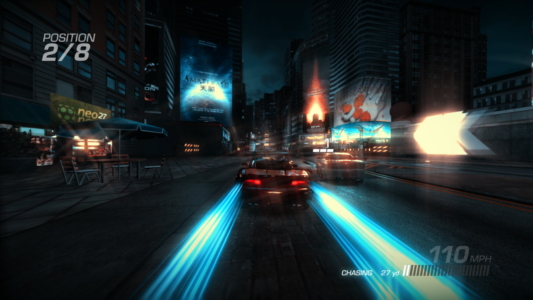
Unbounded does look nice, although some of the lighting might make your head hurt a little after a while.
Broadly, Unbounded is probably best viewed as an attempt to meld the slidey cornering of Ridge with the destruction of Flatout: performing a drift fills a bar on the HUD and ultimately earns you a boost, which can be used to smash through opponents and scenery, earning you points in the process. While you earn points for finishing in the top three, the destruction tops this total up, and so, like in any arcade combat racer worth its salt, success is achieved through a combination of driving skill and hitting supplementary targets.
Each district must be completed via a series of slightly different events, with accumulation of points as you go unlocking more races and progress through districts unlocking more of the city. A standard race involves laps around a city-based circuit, drifting as necessary to build up enough juice to either temporarily knock out opponents up ahead, or earn points by crashing through a car dealership, cinema or sundry other unpopulated location on the side of the road.
The latter is better from a points-scoring point of view, and the intention is seemingly that these paths also act as shortcuts, although the benefits in that regard aren’t always clear, particularly if the slow motion replay of your car emerging largely undamaged from the inside wall of a building finishes with you ploughing fatally into apparently much firmer scenery and erasing any advantage you might have gained. Opponents can target you too, although you do have a visual aid in the form of an orangey red light at the bottom of the screen showing you if you’re in the line of fire, allowing you to pre-empt any attacks without having to resort to the reverse camera.
Alternate events either lean into the driving or destruction elements more heavily. Shindo Racing is laps with no destruction element (boosts are just for speed); there are drift races, reminiscent of Need for Speed: Underground, wherein you attempt to retain a semblance of control over your car while slipping and sliding around a series of corners as a score is built up; and there are also smash-em-crash-em based interludes where you simply have to destroy as many other cars as possible – sometimes in a standard vehicle, and at others while driving a big rig and attempting to bash police cars, rather than racing opponents, out of your way.
The police only feature intermittently, incidentally, and most of the time your racing/revolution is unhindered by the long arm of the law, although most district finale races do feature them in hot pursuit because, the story goes, they’ve finally tired of your antics and are chasing you out of that part of town, putting you into a solo race against the clock, with the cops acting as a distraction. They can’t arrest you, though, and you can boost through those ahead of you to destroy them, although their numbers appear to be refreshed at regular intervals.
It all rumbles along nicely enough for a while, with new cars and events unlocking as you go, and a reasonable amount of variety in the action being provided. Chasing a first place finish in standard races does tend to leave you ignoring the big on-screen symbols urging you to destroy a shopping mall or police station, until it eventually clicks that the extra points are needed to reach pre-set targets and victory alone won’t cut it. Like the old Kudos system of Project Gotham Racing, and numerous other arcade racers inspired by its approach, it’s not just about winning, but winning in style.
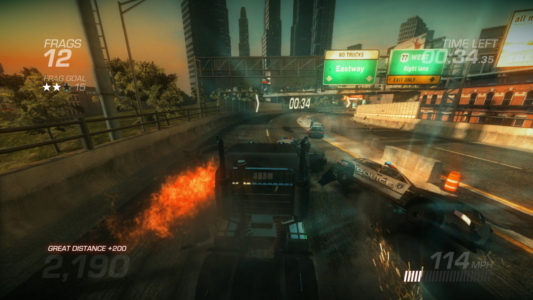
The Unbounded strike back against oppression by meeting a preordained target of wrecked police cars.
In an ideal world though, the system of risk and reward might be better balanced. In Ridge Racer Unbounded, it never quite feels dangerous enough to veer off the road and smash through a building, nor does it confer such a significant advantage that you feel a sense of elation at having done so. Instead, it feels a little like going through the motions: oh, hey, don’t forget to destroy that railway station for extra points, if you feel like it, ok?
Instead, the major source of peril comes from slightly misleading feedback from the onscreen gauges which might occasionally lead you to believe that you can boost through a rapidly approaching wall, only for it to quickly become apparent that you’ll be left short and resigned to a much crunchier fate. There’s also the age-old problem of which objects the game has decided are destructible and which will bring you crashing to a halt: here, concrete pillars are rather crumbly, as are some walls, but others remain sturdily impassable.
Even in the destruction-based races, things don’t quite feel right, with the primacy of the boost in achieving a ‘frag’ meaning that other cheerful mashing of opponents into walls often isn’t recognised as legitimate. Meanwhile, the Shindo races, in taking the destruction element out of the equation altogether, only serve to show up the racing itself as a bit limited. The visuals, with neon streaks bursting through evening twilight, a soundtrack partly borrowed from Ridge Racers past, and the strong encouragement to drift, are all concessions to the requirements of the brand, but underneath, it’s not quite the same game.
Instead, it sort of feels like Flatout has been transposed to a Need for Speed-type environment – in particular, Need for Speed: Carbon – and even retains the same insistence that districts and individual races within them must not simply be won but ‘dominated’. Flatout’s woolly handling doesn’t particularly suit the city, however: instead of careering over hay bales and through open fields, you keep hitting walls. Admittedly, the cars here do feel heavier here, presumably to stop the whole thing devolving into an urban crashfest. There’s also a feeling of a 00s PC racer that persists beyond the slick presentation, particularly on the occasional ‘stunt’ courses, which feel like a relic from something like Crashday rather than the next generation of a famous racing franchise.
As a Ridge Racer game, Unbounded struggles to convince. Whether, taken on its own merits, it’s still a decent racing game, is a slightly trickier question. There’s certainly plenty to enjoy, and most events are diverting enough to have you flipping between vehicles and having another go in search of the best score or time. As in the best examples of the genre, you find yourself weighing up how much to focus on the race and how much to focus on the supplementary targets, and managing to bash through all the major city buildings on your way to victory can be quite satisfying. The time trial escapes from the city and destruction events also keep you slapping the controller for another go – at least for a while, until you realise you probably can’t, or don’t need to, actually get that top score.
At the same time, it’s never totally compelling, or quite manages to convince you of what it wants to do. Unbounded feels slightly out of time, rather like – as previously noted – a 00s Need for Speed game, but released in 2012. The question of what arcade racers could do after street racing had been done to death and become unfashionable seems to have been one reason for the genre’s slump around this time. Ploughing through the walls of city buildings at various stages of a race seems more like something that’s been done before rather than the next big idea.
In fairness, one fairly original feature – at least for a racer of this type and vintage, and admittedly hidden away from the main single-player mode – is the inclusion of a construction kit. However, for whatever reason – most likely, the feeling that my time with the game was already done – my interest wasn’t piqued sufficiently to give it more than a cursory glance. Perhaps it was the realisation – upon viewing all the different building blocks available – that the various races in the districts of Shatter Bay were clipped together in such a fashion, laying bare what had previously been only a passing suspicion of repetitive scenery, of the type present in all these kinds of games. Or maybe I’m too old and lazy to be messing around with construction kits, who knows.
There’s just about enough good stuff in Ridge Racer Unbounded to squeak into the level of a modest recommendation. For someone who feels the same way about arcade racers that he does about takeaway food – it’d have to be pretty bad for me not to enjoy it – it sits somewhere above the poor and average Need for Speeds and amongst the middling to good ones. As a fan of the wide open spaces of Rally Trophy and the compulsive freewheeling action of Flatout 2, however, it feels a bit disappointing not to get more.

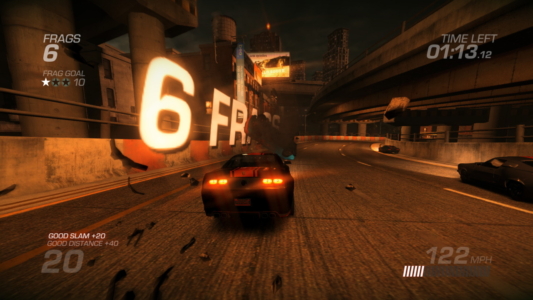
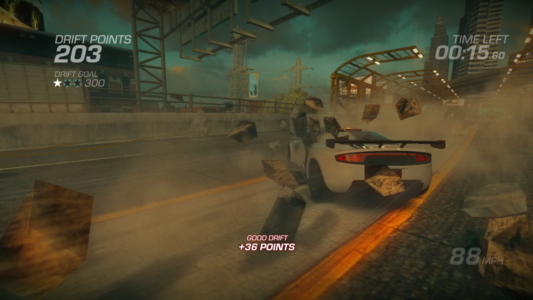
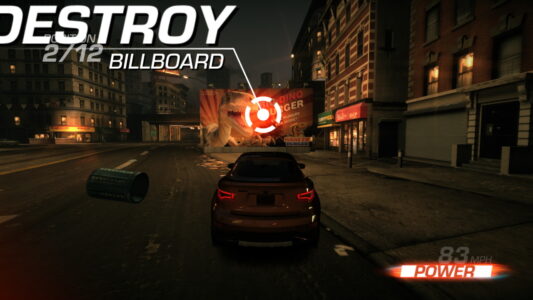
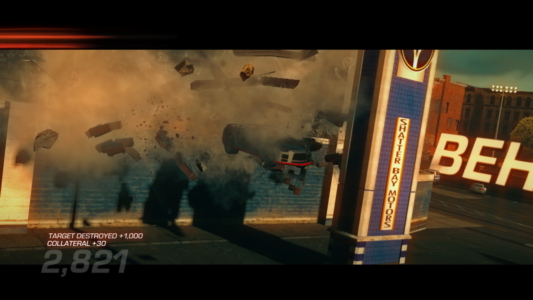

 Posts
Posts